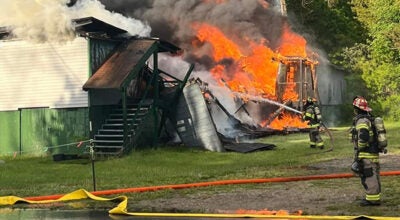Dowagiac Union High School recognized as ‘Heart Safe School’
Published 8:00 am Wednesday, June 4, 2014

Dowagiac Union High School Principle Pieter Hoekstra and Student Athlete Care Provider Doug Michels display the school’s new banner, signifying their status as a Michigan Department of Community Health HEARTSafe School. (Leader photo/TED YOAKUM)
Three years ago, school districts received a shocking reminder that the heart can be a fragile thing, even ones inside of student athletes.
On March 5, 2011, Fennville High basketball star Wes Leonard collapsed on the home court moments after sinking the game winning shot. He was rushed to a nearby hospital, where he was pronounced dead after paramedics failed to revive him with CPR. Medical examiners later determined that his death was the result of cardiac arrest caused by his enlarged heart.
While Leonard’s sudden passing made headlines across the entire nation, his death had a profound affect on the communities across southwest Michigan, including with personnel at Dowagiac Union Schools.
“Leonard was close to home,” said Doug Michels, student athlete care provider with Dowagiac Union High School. “It struck a lot of people around the community.”
To Michels, the tragedy serves as one way to underscore the importance of the efforts the high school has taken to ensure a similar incident doesn’t occur within its halls.
Last month, the Michigan Department of Community Health recognized Dowagiac Union High School as one of the state’s HEARTSafe Schools, a new program the department launched this year. Union High was one of 40 Michigan schools given the designation, and the only one from Cass County.
“[The designation] makes us more prepared for an incident, when it arises,” he said. “It raises awareness among the staff that incidents like this are happening more and more.”
According to a release from MDCH, 246 people between the age of 5 and 19 died of sudden cardiac arrest between 1999 and 2009. The HEARTSafe program is one way the state organization is trying to prevent such deaths from occurring in schools.
Each building that received the title had a number of requirements to fulfill, including having an emergency plan written up, with a team in place to deal with heart-related situations should they occur within school grounds.
“One of the requirements is that 10 percent or more of the general staff has to be CPR and AED certified,” Michels said. “We exceed that requirement, as we have 50 to 60 percent of our staff certified.”
The high school also exceeds the number of required AED devices as well, with three machines located at the high school, one of which Michels carries with him.
“No matter where a student is at, at least one hallway will have a classroom with a teacher who is qualified to deal with the situation,” Michels said.
Receiving the certification is the latest safety milestone that Michels has led the high school toward accomplishing in over 20-year career with the district. The certified EMT first began volunteering as an athletic trainer for the Chieftains in 1992, before moving into his current full-time position in 2000, he said. Besides his duties overseeing the condition of players at various Dowagiac athletic events, he has pushed for CPR training for nearly all the coaches at the school.
“I can’t be at every practice or game,” Michels said. “If something happens and I’m not there, our coaches are certified to help instead.”
Encouraged by the success of the high school’s award, Michels hopes to get the middle school the title in the coming years, as the school already has an AED of its own. He also would like to see the district’s elementary schools receive the title in the future.






